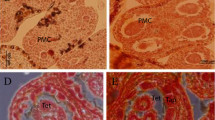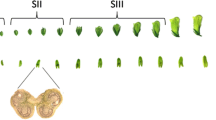Abstract
A full-length genomic clone of 2,233 bp long containing an anther- and tapetum-specific gene TomA108 was isolated and characterized from tomato. The gene was present in one copy per haploid genome. The isolated clone contained 5′ and 3′ untranslated regions of 810 and 170 nucleotides, respectively and a single intron with highly repetitive sequences. The cDNA encoded the protein with an apparent mass of 10.6 kDa and a pI (isoelectric point) of 5.3. It was cysteine-rich and had an N-terminal hydrophobic domain with characteristics of a secretory signal. Amino acid sequence comparisons demonstrated that the protein was closely related to a family of cereal seed storage proteins and protease inhibitors. The fusion of β-glucuronidase to the TomA108 promoter demonstrated that the promoter was highly active from early-meiosis to free microspores production in tapetum of tobacco. This strong and highly specific promoter can be potentially used to generate male sterility for efficient production of plant hybrids.









Similar content being viewed by others
Abbreviations
- GUS:
-
β-Glucuronidase
- EDTA:
-
Ethylene diamine tetraacetie acid
- MADS:
-
MCM1, AGAMOUS, DEFICIENS, and SRF
- CarG:
-
(CC(A/T)6GG)
- GA:
-
Gibbrerllin
- ABA:
-
Abscisic acid
- SA:
-
Salicylic acid
- SDS:
-
Sodium dodecyl sulfate
- IPTG:
-
Isopropyl-1-thio-β-d-alactoside
- PAGE:
-
Polyacrylamide gel electrophoresis
References
Abe H, Urao T, Ito T, Seki M, Shinozaki K, Yamaguchi-Shinozaki K (2003) Arabidopsis AtMYC2 (bHLH) and AtMYB2 (MYB) function as transcriptional activators in abscisic acid signaling. Plant Cell 15:63–78
Achard P, Herr A, Baulcombe DC, Harberd NP (2004) Modulation of floral development by a gibberellin-regulated microRNA. Development 131:3357–3365
Aguirre P, Smith AG (1993) Molecular characterization of a gene encoding a cysteine-rich protein preferentially expressed in anthers of Lycopersicon esculentum. Plant Mol Biol 23:77–487
Allen RD, Bernier F, Lessard PA, Beachy RN (1989) Nuclear factors interact with a soybean beta-conglycinin enhancer. Plant Cell 1:623–631
Bate N, Twell D (1998) Functional architecture of a late pollen promoter: pollen-specific transcription is developmentally regulated by multiple stage-specific and co-dependent activator elements. Plant Mol Biol 37:859–869
Bedinger P (1992) The remarkable biology of pollen. Plant Cell 4:879–887
Bino RJ (1985) Histological aspects of microsporogenesis in fertile, cytoplasmic male sterile and restored fertile Petunia hybrida. Theor Appl Genet 69:425–428
Block MD, Debrouwer D, Moens T (1997) The development of a nuclear male sterility system in wheat. Expression of the barnase gene under the control of tapetum specific promoters. Theor Appl Genet 95:125–131
Budelier KA, Smith AG, Gasser CS (1990) Regulation of a styler transmitting tissue-specific gene in wild-type and transgenic tomato and tobacco. Mol Genet Genomics 224:183–192
Cercos M, Gomez-Cadenas A, Ho THD (1999) Hormonal regulation of a cysteine proteinase gene, EPB-1, in barley aleurone layers: cis- and trans-acting elements involved in the co-ordinated gene expression regulated by gibberellins and abscisic acid. Plant J 19:107–118
Chen RD, Tabaeizadeh Z (1992) Expression and molecular cloning of drought- and ABA-induced genes in the wild tomato Lycopesicon chilense. Biochem Cell Biol 70:199–206
Chen RD, Smith AG (1993) Nucleotide sequence of a stamen- and tapetum-specific gene from Lycopersicon esculentum. Plant Physiol 101:1413
Chen RD, Aguirre P, Smith AG (1994) Molecular characterization and development expression of the anther- and tapetum-specific gene encoding a novel glycine-rich protein from Lycopersicon esculentum. J Plant Physiol 143:651–658
Chen RD, Wang F, Smith AG (1996) A flower-specific gene encoding an osmotin-like protein. Gene 14:301–302
Chen W, Provart NJ, Glazebrook J, Katagiri F, Chang HS, Eulgem T, Mauch F, Luan S, Zou G, Whitham SA, Budworth PR, Tao Y, Xie (2002) Expression profile matrix of Arabidopsis transcription factor genes suggests their putative functions in response to environmental stresses. Plant Cell 14:559–574
Cho HJ, Kim S, Kim M, Kim BD (2001) Production of transgenic male sterile tobacco plants with the cDNA encoding a ribosome inactivating protein in Dianthus sinensis L. Mol Cells 11:326–333
Foster R, Izawa T Chua NH (1994) Plant bZIP proteins gather at ACGT elements. FASEB J 8:192–200
Fuerstenberg SI, Bucciaglia PA, Smith AG (2000) Molecular characterization of an anther-specific gene from tobacco shows sequence similarity to a tapetum-specific gene from tomato. Sex Plant Reprod 12:250–252
Gomez MD, Beltran JP, Canas LA (2004) The pea END1 promoter drives anther-specific gene expression in different plant species. Planta 219(6):967–81
Heslop-Harrison J (1968) Pollen wall development. Science 161:230–237
Higo K, Ugawa Y, Iwamoto M, Higo H (1998a) PLACE: a database of plant cis-acting regulatory DNA elements. Nucleic Acids Res 26:358–359
Higo K, Ugawa Y, Iwamoto M, Higo H (1998b) PLACE: a database of plant cis-acting regulatory DNA elements. Nucleic Acids Res 26:358–359
Jefferson RA (1987) Assaying chimeric genes in plants: the GUS gene fusion system. Plant Mol Biol Reports 4:387–405
Kapoor S, Kobayashi A, Takatsuji H (2002) Silencing of the tapetum-specific zinc finger gene TAZ1 causes premature degeneration of tapetum and pollen abortion in petunia. Plant Cell 14:2353–2367
Koltunow A, Truettner J, Cox KH, Wallroth M, Goldberg RB (1990) Different temperal and spatial gene expression patterns occur during anther development. Plant Cell 2:1201–1224
Lauga B, Charbonnel-Campaa L, Combes D (2000) Characterization of MZm3-3, a Zea mays tapetum-specific transcript. Plant Sci 157:65–75
Lee YK, Chung KH, Kin HU, Jin YM, Kim HI Park BS (2003) Induction of male sterile cabbage using a tapetum-specific promoter from Brassica campestris L. ssp. Pekinensis. Plant Cell Rep 22:173–268
Lessard PA, Allen RD, Bernier F, Crispino JD, Fujiwara T, Beachy RN (1991) Multiple nuclear factors interact with upstream sequences of differentially regulated beta-conglycinin genes. Plant Mol Biol 16:397–413
MacCormick S, Niedermeyer J, Fry J, Barnason A, Horsch R, Fraley R (1986) Leaf disc transformation of cultivated tomato (L. esculentum) using agrobacterium tumefaciens. Plant Cell Rep 12:81–84
Maniatis T, Fritsch EF, Sambrook J (1982) Molecular cloning: a laboratory manual. Cold Spring Harbor Laboratory Press, Cold Spring Harbor Laboratory, New York
Mariani C, De Beuckeleer M, Treuttner J, Leemans J, Goldberg RB (1990) Induction of male sterility in plants by a chimeric ribonuclease gene. Nature 347:737–741
Mundy J, Rogers JC (1986) Selective expression of a probable amylase/protease inhibitor in barley aleurone cells: comparison to the barley amylase/subtilisin inhibitor. Planta 169:51–63
Nacken WKF, Huijser J, Beltran JP, Suedler H, Sommer H (1991) Molecular characterization of two stamen-specific genes, tap1 and fil1 that are expressed in the wild type, but not in the deficiens mutant of Antirrbinum majus. Mol Genet Genomics 229:129–136
Nakamura Y, Sato S, Asamizu E, Kaneko T, Kotani H, Miyajima N and Tabata S (1998) Structural analysis of Arabidopsis thaliana chromosome 5. VII. Sequence features of the regions of 1,013,767 bp covered by sixteen physically assigned P1 and TAC clones. DNA Res 5:297–308
Park BS, Jin YM, Kim HI (2003) A tapetum-specific gene, BcA9, of Chinese cabbage. In: EMBL, GenBank and DDBJ nucleotide sequence databases under the accession number AAO85389.1 GI:29569832
Perez-Prat E, Campagne MML (2002) Hybrid seed production and the challenge of propagating male sterile plants. Trends Plant Sci 7:199–203
Rogers HJ, Bate N, Combe J, Sullivan J, Sweetman J, Swan C, Lonsdale DM, Twell D (2001) Functional analysis of cis-regulatory elements within the promoter of the tobacco late pollen gene g10. Plant Mol Biol 45:577–58
Rubinelli P, Hu Y, Ma H (1998) Identification, sequence analysis and expression studies of novel anther-specific genes of Arabidopsis thaliana. Plant Mol Biol 37:607–619
Schrauwen JAM, Mettenmeyer T, Croes AF, Wullems GJ (1996) Tapetum-specific genes: what role do they play in male gametophyte development? Acta Bot Neerl 45:1–15
Simpson SD, Nakashima K, Narusaka Y, Seki M, Shinozaki K, Yamaguchi-Shinozaki K (2003) Two different novel cis-acting elements of erd1, a clpA homologous Arabidopsis gene function in induction by dehydration stress and dark-induced senescence. Plant J 33:259–270
Smith AG, Pring DR (1987) Nucleotide sequence and molecular characterization of a maize mitochondrial plasmid-like DNA. Current Genet 12:617–623
Smith AG, Gasser CS, Budelier KA, Fraley RT (1990) Identification and characterization of stamen- and tapetum-specific genes from tomato. Mol Genet Genomics 222:9–16
Takishima K, Wantanabe S, Yamada M, Suga T, Mamiya G (1988) Amino acid sequence of two nonspecific lipid-transfer proteins from germinated castor bean. Eur J Biochem 177:241–249
Tang W, Perry SE (2003) Binding site selection for the plant MADS domain protein AGL15: an in vitro and in vivo study. J Biol Chem 278:28154–28159
Twell D, Wing R, Yamaguchi J, McCormick S (1989) Isolation and expression of an anther-specific gene from tomato. Mol Genet Genomics 217:240–245
von Heijne G (1986) A new method for predicting signal sequence cleavage sites. Nucleic Acids Res 14:4683–4690
Wyatt P, Hodge R, Smartt S, Draper J, Scott R (1992) The isolation and characterization of the tapetum-specific Arabidopsis thaliana A9 gene. Plant Mol Biol 19:611–622
Yanagisawa S, Schmidt RJ (1999) Diversity and similarity among recognition sequences of Dof transcription factors. Plant J 17:209–214
Yanagisawa S (2004) Dof domain proteins: plant-specific transcription factors associated with diverse phenomena unique to plants. Plant Cell Physiol 45:386–91
Yu D, Chen C, Chen Z (2001) Evidence for an important role of WRKY DNA binding proteins in the regulation of NPR1 gene expression. Plant Cell 13:1527–1540
Zhang ZL, Xie Z, Zou X, Casaretto J, Ho TH, Shen QJ (2004) A rice WRKY gene encodes a transcriptional repressor of the gibberellin signaling pathway in aleurone cells. Plant Physiol 134:1500–13
Zhou DX (1999) Regulatory mechanism of plant gene transcription by GT-elements and GT-factors. Trends Plant Sci 4:210–214
Author information
Authors and Affiliations
Corresponding author
Additional information
Communicated by Y. Lu
An erratum to this article can be found at http://dx.doi.org/10.1007/s00299-009-0682-6.
Rights and permissions
About this article
Cite this article
Xu, S.X., Liu, G.S. & Chen, R.D. Characterization of an anther- and tapetum-specific gene and its highly specific promoter isolated from tomato. Plant Cell Rep 25, 231–240 (2006). https://doi.org/10.1007/s00299-005-0056-7
Received:
Revised:
Accepted:
Published:
Issue Date:
DOI: https://doi.org/10.1007/s00299-005-0056-7




